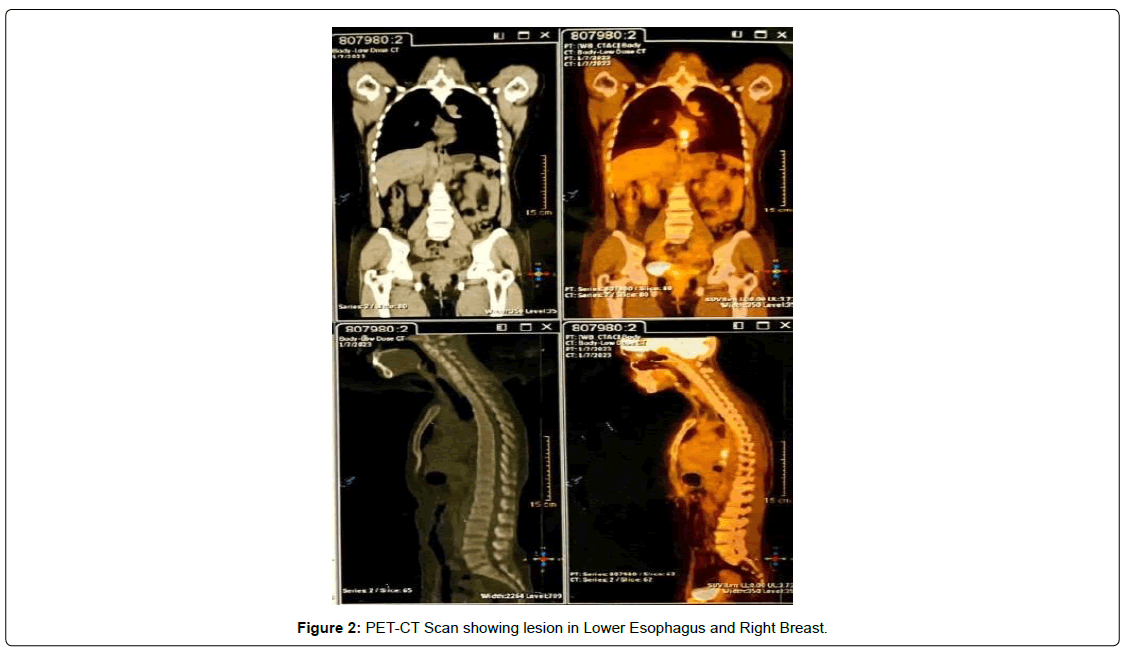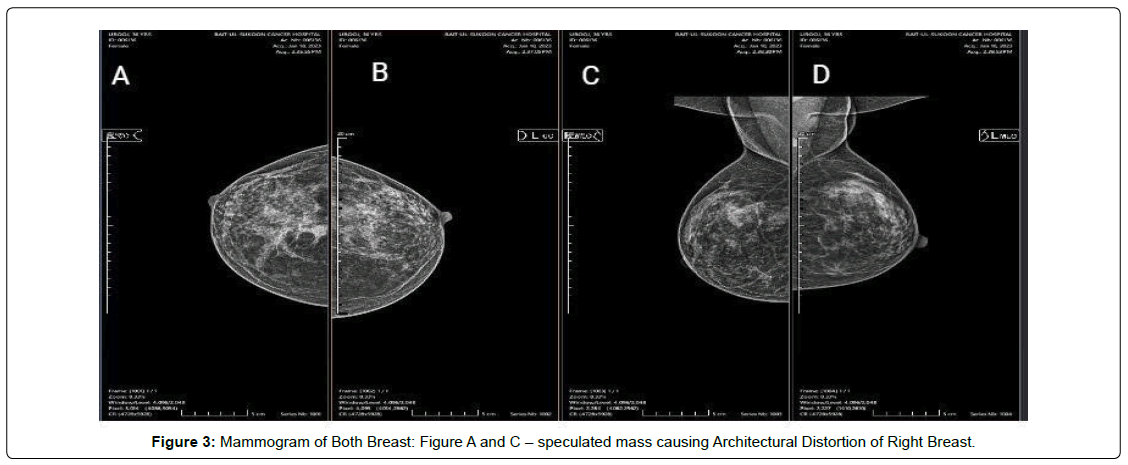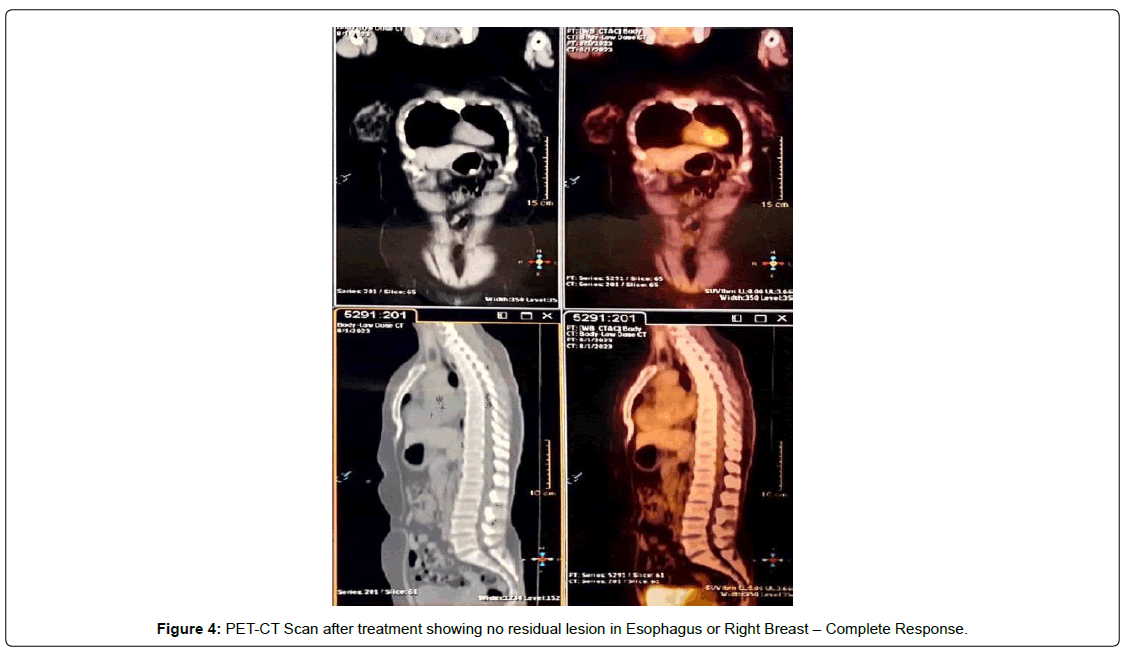Case Report, Jrgm Vol: 13 Issue: 2
Dual Primary Malignancies Breast Cancer and Esophageal Cancer: A Case Report
Namra Naseer1, Fatima Khurshid2*, Yumna Khan1, Rabail Taj1, Abdul Qayyum1
1Medical Doctor, Department of Oncology, Bait ul Sukoon – Cancer Hospital and Hospice, Pakistan
2Medical Doctor, Department of Radiation Oncology, Shifa International Hospital ltd. Islamabad. Pakistan
*Corresponding Author: Khurshid F
Department of Radiation Oncology, Shifa International Hospital Ltd. Islamabad. Pakistan
E-mail: fatimakhurshid61@yahoo.com
Received: 20-Feb-2024, Manuscript No. JRGM-24-127897;
Editor assigned: 22-Feb-2024, PreQC No. JRGM-24-127897(PQ);
Reviewed: 07-Mar-2024, QC No. JRGM-24-127897;
Revised: 08-Mar-2024, Manuscript No. JRGM-24-127897(R);
Published: 15-Mar-2024, DOI:10.4172/2325-9620.1000298
Citation: Naseer N, Khurshid F, Khan Y, Taj R & Qayyum A (2024) Dual Primary Malignancies Breast Cancer and Esophageal Cancer: A Case Report. J Regen Med; 13:2.
Copyright: © 2024 Khurshid F. This is an open-access article distributed under the terms of the Creative Commons Attribution License, which permits unrestricted use, distribution and reproduction in any medium, provided the original author and source are credited.
Abstract
The incidence of concurrent esophageal cancer and breast cancer is relatively uncommon, and there have been a few cases indicating a slight increase in the occurrence of Multiple Primary Carcinomas (MPCS) alongside esophageal cancer. A 36-year-old female patient sought medical attention at the outpatient department due to difficulty in swallowing. A histopathological examination confirmed the presence of squamous cell carcinoma in the esophagus. Surprisingly, within a month of her initial diagnosis, she was incidentally found to have a simultaneous breast tumor. Both tumors responded positively to chemotherapy, and a mid-treatment pet scan indicated complete remission. Studying cases of multiple synchronous primary tumors like this one can provide valuable insights for the development of more effective screening and surveillance protocols, ultimately improving patient care.
Keywords: Esophageal Cancer, Breast Cancer, Multiple Primary Carcinomas (MPCs), Synchronous Tumors, Squamous Cell Carcinoma
Introduction
Breast cancer and esophageal cancer often occur in association with cancers of other organs However, there are few cases of double primary breast and esophageal cancers [1]. In this report, we present a case involving synchronous double cancers affecting both the esophagus and the right breast. When dealing with cases of synchronous multiple cancers accompanied by distant metastasis (such as in the liver, lungs, or distant lymph nodes), it can be challenging to determine the primary site of metastasis and establish the order of priority for treatment among these simultaneous cancers [2]. Fortunately, in this particular case, no distant metastases were observed. These two cancers can either be detected sequentially, with one following the other after a certain period (metachronous), or simultaneously (synchronous). Despite breast cancer being a common occurrence in females, the coexistence of primary cancers in both the esophagus and breast within a single patient is an exceptionally rare occurrence in the medical literature. This rarity has prompted us to document and publish this case.
Case Report
In December 2022, a 36-year-old female patient presented to our outpatient department with a chief complaint of dysphagia. Upon initial examination, her vital signs were stable, and there were no notable findings. Esophagogastroscopy was conducted, revealing a 2.5 cm flat lesion with raised margins and abnormal-looking mucosa located 30 cm from the incisors. Additionally, a subcentimeter lipomatous swelling was observed just above the Z line. A biopsy sample was obtained, and subsequent histopathological examination confirmed moderately differentiated squamous cell carcinoma.
Further diagnostic evaluation through computed tomography (CT) demonstrated thickening at the gastroesophageal junction and enlarged celiac lymph nodes. However, no invasion of the esophageal tumors into adjacent organs was noted (Figure 1).
A PET-CT scan revealed an avid mural mass associated with paraesophageal lymph nodes, involving the thoracic esophagus from D8-D9, with a craniocaudal extent of 4.0 cm, consistent with a clinical staging of T1 N1 M0. The PET-CT scan also incidentally identified a lesion in the right breast, approximately measure 1.4 x 1.2 cm SUV Max 6.0 which was not previously visible on the CT scan (Figure 2).
To further investigate these breast findings, bilateral mammogram and ultrasound were performed. Slightly an ill-defined opacity seen at lower inner quadrant of right breast well appreciated on focal spot view. Concomitant ultrasound of the right breast revealed a well-defined lobulated hypo echoic lesion at the 4 o’clock position, measuring approximately 2.0 x 1.3 cm and located 0.9 cm from the skin, with increased vascularity on color duplex imaging. Additionally, another oval hypo echoic lesion was detected at the 10 o’clock position of the right breast, measuring approximately 1.6 x 0.6 cm and located 0.6 cm from the skin. In conclusion the bilateral mammogram classified as BIRADS Va in right breast, while the left breast was categorized as BIRADS I (Figure 3).
To confirm the diagnosis of the right breast lesion, a core biopsy was performed, which revealed invasive carcinoma of the breast of no special type (ductal), most likely grade II. The tumor was negative for human epidermal growth factor receptor 2 (HER2), estrogen receptors (ER), and progesterone receptors (PR), categorizing it as triple-negative.
Following a comprehensive evaluation, the diagnosis of esophageal squamous cell cancer (T1 N1 M0, stage IIB) and synchronous invasive ductal carcinoma (IDC) of the right breast (T1c N0 M0, stage I) was established. The patient received detailed counseling, and a chemotherapy protocol was initiated. She commenced treatment with Paclitaxel + Carboplatin every 3 weeks and completed a total of 6 doses. Notably, the patient’s initial complaint of dysphagia improved, and subsequent examinations were unremarkable. A PET scan, conducted after the initial treatment, indicated a complete response (Figure 4).
Future treatment plans include concurrent chemo radiotherapy (CCRT) for the esophagus, followed by further treatment of the right breast.
Discussion
To characterize multiple primary tumors, three essential criteria must be met: (A) each tumor should exhibit clear distinctions from the others, (B) each tumor must display unequivocal malignancy features, and (C) the possibility of one being a metastasis of another must be definitively ruled out [3]. When these tumors are diagnosed either simultaneously or within a 6-month interval, they are termed synchronous; however, if the interval between diagnoses extends beyond this timeframe, they are referred to as metachronous. Bagri PK et al.’s study reported 41 cases of multiple primary malignancies, with 8 being synchronous (19.51%) and 33 being metachronous (80.49%) [4].
Multiple primary tumors often prompt questions about shared etiological factors and similar pathogenesis. However, they present significant challenges for both clinicians and patients due to the limitations they impose on therapeutic options [3]. Fortunately, in this particular case, the patient exhibited a positive response to six doses of Paclitaxel + Carboplatin.
Advancements in genetic research conducted over recent decades have led to the identification of numerous cancer susceptibility genes. Mutations in tumor suppressors and proto-oncogenes have been implicated in the syndromic manifestation of secondary primary cancers [5]. Therefore, the potential existence of multiple primary malignancies should routinely be considered during pre-treatment evaluation. Screening procedures play a crucial role in the early detection of associated tumors, ideally before clinical symptoms manifest. In our case, the incidental discovery of synchronous breast cancer significantly altered the treatment trajectory. Ultimately, the selection of appropriate chemotherapeutic agents and regimens remains pivotal in managing patients with multiple primary malignancies [6].
Conclusion
The presented case underscores the critical importance of screening procedures in the early detection of tumors, allowing for timely intervention and improved patient outcomes. Additionally, the diligent monitoring of patients undergoing treatment for primary cancer plays a pivotal role in identifying secondary tumors at an early stage, facilitating effective management strategies.
In summary, the examination of cases involving multiple primary tumors offers valuable insights into the development of robust screening and surveillance protocols. These protocols are essential tools in the comprehensive care of patients, with the ultimate goal of providing timely and efficient treatment. The continuous study of such cases contributes to ongoing advancements in oncology, ultimately benefiting the broader patient population by enhancing our ability to detect and manage cancer effectively.
References
- Yokoi S, Maeda H, Nishino T, Togawa T, Iida A, Goi T(2019) Double Primary Recurrent Human Epidermal Growth Factor Receptor 2-Positive Breast Cancer And Esophageal Cancer That Responded Well To Chemotherapy. Int Cancer Conf J; 8(1):17-23
- Akiyama Y, Iwaya T, Shioi Y, Endo F, Ishida K, et al. (2015) Successfully Treated Advanced Esophageal Cancer With Left Axillary Lymph Node Metastasis And Synchronous Right Breast Cancer: A Case Report. Surg Case Rep; 1: 1-7.
- Sakellakis M, Peroukides S, Iconomou G, Boumpoucheropoulos S, Kalofonos H (2014) Multiple Primary Malignancies: A Report Of Two Cases. Chin J Cancer Res; 26(2):215-218.
- Bagri PK, Singh D, Singhal MK, Singh G, Mathur G, et al. (2014). Double Primary Malignancies: A Clinical & Pathological Analysis Report from A Regional Cancer Institute In India. Iran J Cancer Prev: 7(2):66.
- Nguyen DT, Nguyen LM, Phan TL, Bui QV (2023) One Patient with 4 Different Primary Cancers: A Case Report. Clin Med Insights Case Rep; 16:11795476221150597.
- Takalkar U, Asegaonkar BN, Kodlikeri P, Asegaonkar S, Sharma B, et al. (2013) An Elderly Woman With Triple Primary Metachronous Malignancy: A Case Report And Review Of Literature. Int J Surg CaseRep;4(7):593-596.
Indexed at, Google Scholar, Cross Ref
Indexed at, Google Scholar, Cross Ref
Indexed at, Google Scholar, Cross Ref
Indexed at, Google Scholar, Cross Ref
 Spanish
Spanish  Chinese
Chinese  Russian
Russian  German
German  French
French  Japanese
Japanese  Portuguese
Portuguese  Hindi
Hindi 



